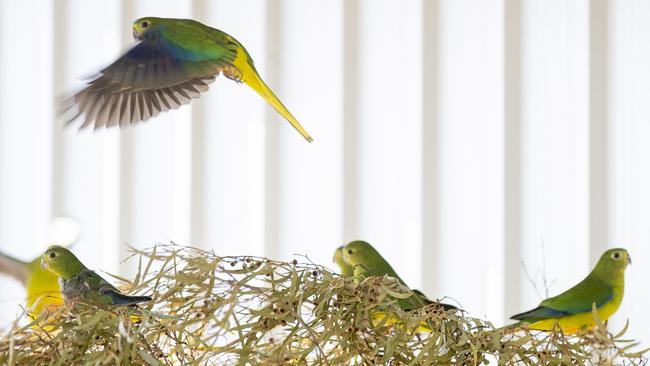How man orange bellied parrots died in captivity?
A program to bring the orange bellied parrot back from the brink of extinction has seen success, but not all birds have survived. Find out why 97 have died over five years.

Tasmania
Don't miss out on the headlines from Tasmania. Followed categories will be added to My News.
OVER the past five years, 60 orange bellied parrots in the government’s captive breeding program were euthanised as a result of illness, welfare concerns or injury, but the number of birds killed by rodents has dropped to zero.
Despite the setbacks, 74 of the critically endangered parrots were sighted in the wild at the small remote area in the Southwest National Park, an increase of four birds from last season.
It’s a good sign, but the government’s breeding program based at Five Mile Beach is still a very important part of boosting the species chances of survival.
Sadly, not all birds have survived the program; according to the Department of Natural Resources and Environment Tasmania (NRE Tas) report, there were 97 birds out of 1361 (14 per cent) which died in captivity within a five-year period.
Last year seven birds died of injury or illness and 13 which were euthanised.
“NRE Tas veterinarians visit the site to provide treatment to sick or injured birds and the majority recover from treatment,” an NRE spokesman said.

“However, to avoid any further suffering or animal welfare issues, in some instances birds may need to be euthanised.”
One of the reasons the birds were moved to a new facility at Five Mile Beach in 2019 was because of problems with rodents getting onto the old, ageing facility.
Efforts to stop birds from falling victim to rodents has been successful, with the number of birds predated on reduced to zero.
“The Tasmanian Government invested $2.5m in the fit for purpose facility which has a range of predator control measures including an exclusion fence to prevent predators from entering the site and rodent control measures managed by a pest control contractor,” the spokesman said.

“The exclusion fence is inspected daily, and the pest controller regularly visits the site.
“There have been no orange-bellied Parrots predated by rodents since moving to the new facility in July 2019.”
The spokesman said the population had increased after the move.
“Since 1991 there have been 845 Orange bellied Parrots released in the wild in the breeding range in Tasmania (as of December 2022).”
There have also been 139 birds released at sites on the mainland in the winter range.
Of the 845 birds released in Tasmania, 449 were released at Melaleuca, 27 at New Harbour and 369 at Birchs Inlet
Originally published as How man orange bellied parrots died in captivity?





